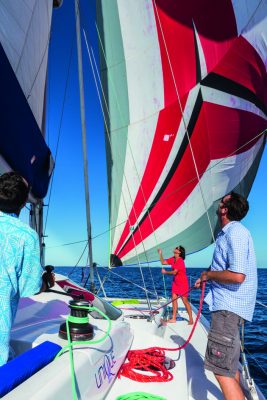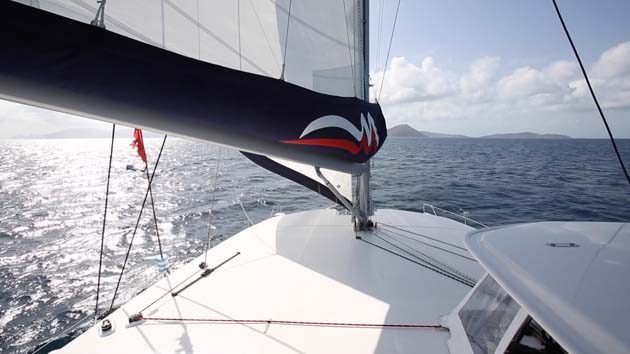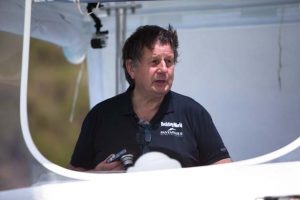Choice of sails and an awareness of your VMG are important when sailing a catamaran downwind, says Nigels Irens
 Generally speaking, the risk of getting into trouble in a catamaran when sailing downwind is greater than when sailing upwind. This is fundamentally owing to the fact that when heading upwind spilling wind is always an option if the wind speed increases unexpectedly for any reason.
Generally speaking, the risk of getting into trouble in a catamaran when sailing downwind is greater than when sailing upwind. This is fundamentally owing to the fact that when heading upwind spilling wind is always an option if the wind speed increases unexpectedly for any reason.
The right strategy for getting the best performance out of a catamaran downwind will depend very much on the speed potential built into the multihull you are sailing.
A bit of background here: any boat that sails slowly, irrespective of how many hulls it has, needs to set lots of sail area and sail deep downwind if it is to achieve a decent speed made good (VMG) – ie typically between 160° and 170° – or within 10-20° of the dead downwind line if you prefer.
Whether you are aboard a monohull or multihull, sailing dead downwind doesn’t usually work well in terms of VMG – mainly because in that condition apparent wind speed (AWS) is limited to true wind speed (TWS) minus your boat speed over the ground (SOG) so it is impossible to generate any apparent wind – as you go faster you simply sail away from it.
Wind shadow
Another problem is that sails tend to shadow one another on this course so it’s hard, for example, to get much help from a foresail that is in the wind shadow of the mainsail.
As it happens, this dead downwind course will also mean that you are running a permanent risk of an accidental gybe – particularly in any kind of seaway, although in a catamaran at least you won’t have the cyclic rolling problem that conventional single-hulled boats suffer from if they sail too deep downwind.

Keeping the main under control through the gybe is important, especially as many modern cruising mainsails are fully battened and have plenty of sail area
So assuming your catamaran is a bread-and-butter cruiser, without much performance capability, you’ll be doing much as you would do in an equivalent monohull, which is setting either a conventional symmetrical spinnaker or perhaps an asymmetric one.
Symmetric spinnaker
The symmetric one has the advantage that when you gybe there’s not much to do as the flow is simply reversed across the sail on the other gybe. On the other hand, to make the most of that sail you’d really need to set a conventional spinnaker pole – as seen on single-hulled boats of limited speed capability – and that means swapping the pole to the other side as you go through the gybe.
In reality, you don’t see many spinnaker poles on catamarans flying symmetrical spinnakers. When gybing, most people simply haul the new tack down to the new windward bow and allow the old tack to be drawn back by the new sheet on the new leeward side.
In practice, this arrangement works less well than you might hope, mainly because if the tack of the sail is to be able to function as a clew on the other gybe, then it needs to be cut quite high.
On the other hand when that corner of the sail is working as a tack it would work better if it was lower – and so able to be drawn right out to the windward bow.
Asymmetric spinnaker
For this reason most modern catamarans choose to fly an asymmetric spinnaker and tack it to the weather bow. If you go down this route and because it is asymmetric, you need to turn the sail inside out when you gybe.
 To do that you need to haul the tack of the spinnaker over to the other bow as you gybe. Before doing that you need to release the old sheet and allow the sail to stream forward in preparation for hauling in again on the new leeward side.
To do that you need to haul the tack of the spinnaker over to the other bow as you gybe. Before doing that you need to release the old sheet and allow the sail to stream forward in preparation for hauling in again on the new leeward side.
Over the years sailmakers have managed to design these asymmetric sails so that they have more volume aloft, so that even when you are sailing quite deep angles the luff of the sail is setting well to windward (a bit like a kite) and so is able to ‘grab’ more wind that would have passed to windward of the boat and draw it across the sail from windward to leeward.
This configuration is pretty much as good as it gets for a cruising catamaran and a sail like this might be good for a range of apparent wind angles of between 160-90°.
Gennaker or screecher
The faster a boat sails, the more time it spends with the apparent wind forward of the beam, 90° or less. As a result, the standard downwind sail used by a true race boat, called a gennaker or screecher (US), looks more like a big jib. The faster the boat, the flatter the sail is cut. An iceboat – which is faster than anything on the draggy old water – sails with a single ‘mainsail’ which you’ll see set as flat as a board on all points of sailing.
Back in the domain of cruising catamarans these big downwind sails have a lot going for them because the beauty of any sail set forward of the mast is that if there should be a sudden wind increase the sheet can be released and the sail allowed to depower by streaming downwind.
That means that when on passage a cruising catamaran can always be rendered safe if things get a little out of hand. All being well it can be ‘snuffed’ – ideally while in the lee of the mainsail.
Unstable weather
If the weather is a bit unpredictable – perhaps there is a threat of tropical line squalls around, for example – then an experienced catamaran skipper might think of keeping average speeds up by using an asymmetric spinnaker while taking a reef or two in the mainsail. The latter can neither be dumped nor lowered if the boat is caught in sudden squall from abaft the beam.

Few cats have vangs, which means that the twist in the main is controlled by the mainsheet and traveller – if you have one
All would be well if you could turn the catamaran round head to wind to take in a reef if such a squall struck unexpectedly – perhaps at night – but the danger is that it may already be too late to round up in those conditions without the ability to depower that big mainsail through dumping the sheet or lowering the sail.
More will be said later on in this series about the safety issues that arise when cruising in a catamaran.
Do’s and don’ts
- DO get good advice from a catamaran-savvy sailmaker with regard to the choice of sails to match your cruising plans.
- DO keep abreast of what other catamaran sailors have learned over the years. Pooling experience makes sense and online forums help spread the word.
- DO try to put some time in on a beach cat in order to get used to the way a catamaran works. If you can handle one of those with confidence you should have no problem with a cruising cat.
- DON’T leave a full main up if cruising downwind in unstable weather – set a sail that’s flown ahead of the mast instead, it’s easier to lower or reef if the breeze builds.
- DON’T overlook the need to practise sail handling/changes in relatively benign conditions before having to perform them for real in a blow.
- DON’T forget the importance of prioritising VMG towards your destination. If the boat you are sailing is a faster multihull the longer route may well be the shortest in elapsed time.
Our eight-part Catamaran Sailing Skills series by Nigel Irens, in association with Pantaenius, is essential reading for anyone considering a catamaran after being more familiar with handling a monohull.
Part 6: Coping with heavy weather
 Series author: Nigel Irens
Series author: Nigel Irens
One name stands out when you think of multihull design: the British designer Nigel Irens.
His career began when he studied Boatyard Management at what is now Solent University before opening a sailing school in Bristol and later moving to a multihull yard. He and a friend, Mark Pridie, won their class in the 1978 Round Britain race in a salvaged Dick Newick-designed 31-footer. Later, in 1985, he won the Round Britain Race with Tony Bullimore with whom he was jointly awarded Yachtsman of the Year.
His first major design success came in 1984 when his 80ft LOA catamaran Formule Tag set a new 24-hour run, clocking 518 miles. During the 1990s it was his designs that were dominant on the racecourse: Mike Birch’s Fujicolour, Philippe Poupon’s Fleury Michon VIII, Tony Bullimore’s Apricot. Most famous of all was Ellen MacArthur’s 75ft trimaran B&Q, which beat the solo round the world record in 2005.
His designs have included cruising and racing boats, powerboats and monohulls, but it is multis he is best known for.
A special thanks to The Moorings, which supplied a 4800 cat out of their base in Tortola, BVI. www.moorings.com





 Series author: Nigel Irens
Series author: Nigel Irens